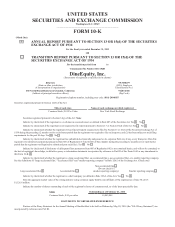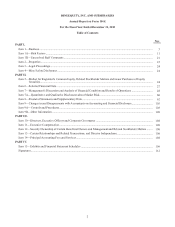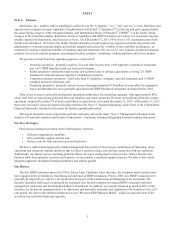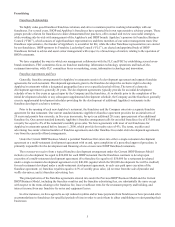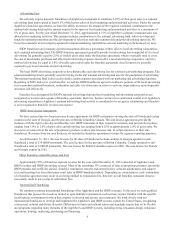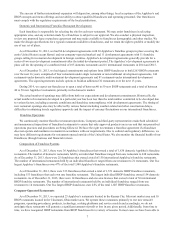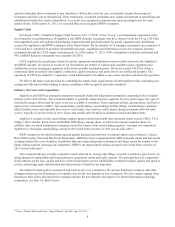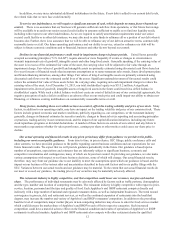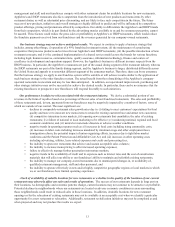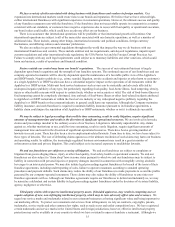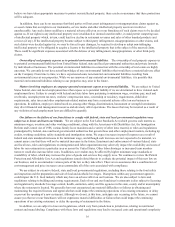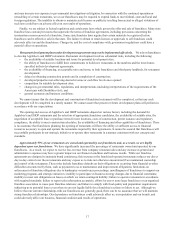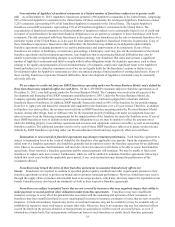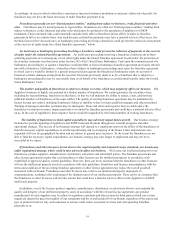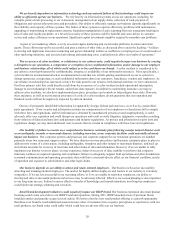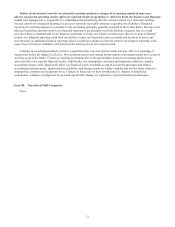IHOP 2013 Annual Report Download - page 32
Download and view the complete annual report
Please find page 32 of the 2013 IHOP annual report below. You can navigate through the pages in the report by either clicking on the pages listed below, or by using the keyword search tool below to find specific information within the annual report.11
the respective fiscal year. There were 52 weeks in our 2013, 2012 and 2011 fiscal years, which ended on December 29, 2013,
December 30, 2012, and January 1, 2012, respectively.
Available Information
Our annual reports on Form 10-K, quarterly reports on Form 10-Q, current reports on Form 8-K, proxy statements and
amendments to those reports filed with or furnished to United States Securities and Exchange Commission (the “SEC”)
pursuant to Section 13(a) or 15(d) of the Securities Exchange Act of 1934, as amended, are available free of charge through our
website as soon as reasonably practicable after electronically filing such material with the SEC. The SEC maintains an Internet
site that contains reports, proxy and information statements and other information regarding our filings at www.sec.gov. In
addition, the public may read and copy the materials we file with the SEC at the SEC's Public Reference Room at 100 F. Street,
NE, Washington, D.C. 20549. Information regarding the operation of the Public Reference Room may be obtained by calling
the SEC at 1-800-SEC-0330. The above references to our website and the SEC’s website do not constitute incorporation by
reference of the information contained on those websites and should not be considered part of this document.
Item 1A. Risk Factors.
General
This Item 1A includes forward-looking statements. You should refer to our discussion of the qualifications and limitations
on forward-looking statements included in Item 7.
The occurrence of any of the events discussed in the following risk factors may materially adversely affect our business,
financial condition and results of operations, which may materially adversely affect the value of our shares of common stock.
Our business is affected by general economic conditions that are largely out of our control. Our business is dependent
to a significant extent on national, regional and local economic conditions, and, to a lesser extent, on global economic
conditions, particularly those conditions affecting the demographics of the guests that frequently patronize Applebee's or IHOP
restaurants. If our customers' disposable income available for discretionary spending is reduced (because of circumstances such
as job losses, credit constraints, higher housing costs, increased tax rates, energy costs, interest rates or other costs) or if the
perceived wealth of customers decreases (because of circumstances such as lower residential real estate values, increased
foreclosure rates, increased tax rates or other economic disruptions), our business could experience lower sales and customer
traffic as potential customers choose lower-cost alternatives (such as quick-service restaurants or fast casual dining) or choose
alternatives to dining out. Any decreases in customer traffic or average value per transaction due to these or other reasons
could:
• reduce gross sales at franchise restaurants, resulting in lower royalty and other payments from franchisees,
• reduce the profitability of franchise restaurants, potentially impacting the ability of franchisees to make royalty
payments when they are due and to develop new restaurants as may be required in their respective development
agreements, and
• negatively impact the financial performance of our company-operated restaurants.
Our level of indebtedness could adversely affect our financial health and prevent us from fulfilling our obligations
under our debt. As of December 31, 2013, we had $1.2 billion of outstanding Senior Notes and Term Loans. In addition, we
had approximately $0.2 billion in financing and capital lease obligations as of December 31, 2013. Our level of indebtedness
could have important consequences to our financial health. For example, it could:
• make it more difficult for us to satisfy our obligations with respect to our debt;
• increase our vulnerability to general adverse economic and industry conditions or a downturn in our business;
• require us to dedicate a substantial portion of our cash flow from operations to debt service, thereby reducing the
availability of our cash flow to pay dividends to our stockholders, repurchase shares of our common stock, fund
working capital, capital expenditures and other general corporate purposes;
• limit our flexibility in planning for, or reacting to, changes in our business and the industry in which we operate;
• place us at a competitive disadvantage compared to our competitors that are not as highly leveraged;
• limit, along with the financial and other restrictive covenants in our indebtedness, among other things, our ability to
borrow additional funds; and
• result in an event of default if we fail to satisfy our obligations under our debt or fail to comply with the financial and
other restrictive covenants contained in our debt documents, which event of default could result in all of our debt
becoming immediately due and payable and could permit certain of our lenders to foreclose on our assets securing
such debt.


